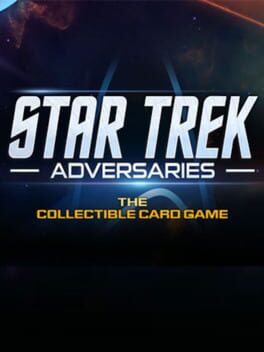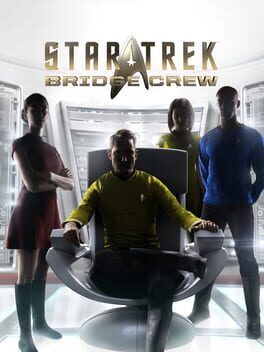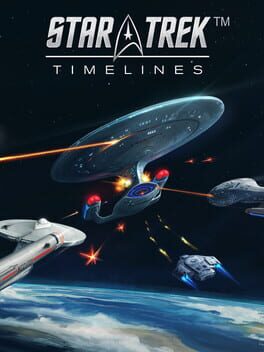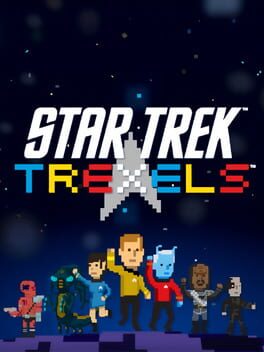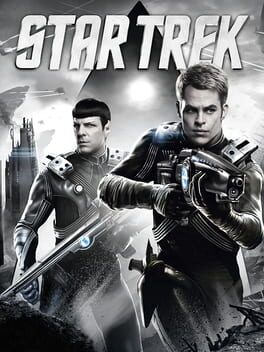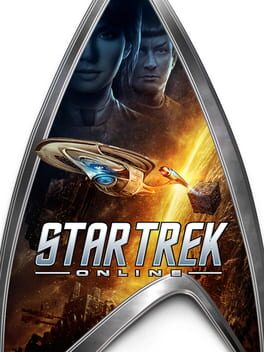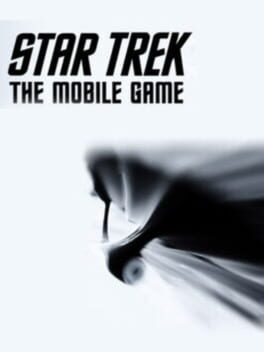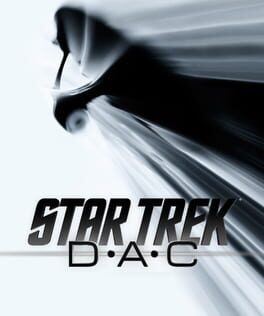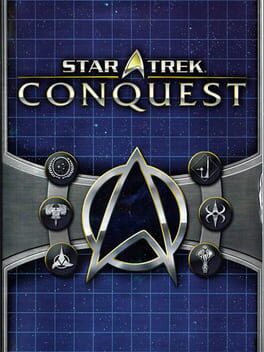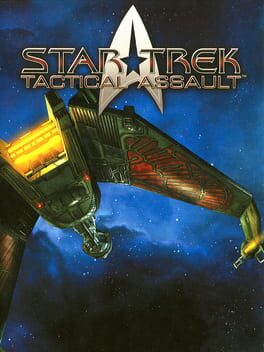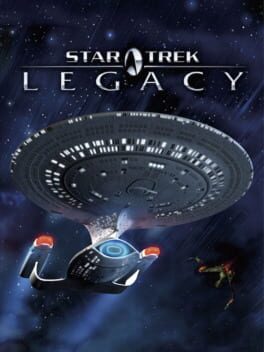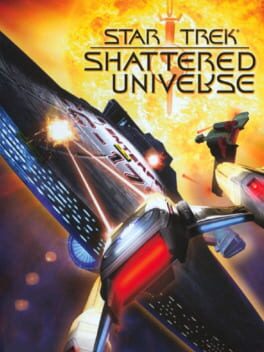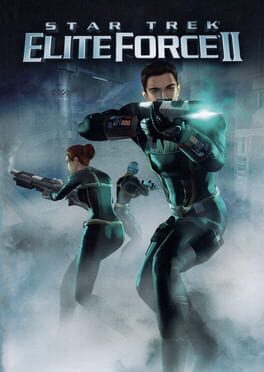Cube1701
Star Trek: Adversaries was a fast-paced card game that had a good response from critics. It was a digital collectable card game that featured some really nice starship models – and quite a lot of them. Unfortunately, the game was shut down and servers taken offline before it was even live for a full year. Booting up the game just gives you a login error.
However, this is a card game, and the information on the cards was kept on the Wiki for the game, so by figuring out the rules, creating needed tokens, I was able to recreate the game in Tabletop Simulator, just without the automation. It’s doesn’t have the fancy effects or the 3D models, but I can still try out the gameplay.
It’s a really fun game that reminds me a bit of Star Realms. Most of your cards are ships that can be enhanced by crew. You put them into play and can attack the opponents ship or their flagship – with the overall goal being destroying the flagship.
Each turn, the amount of energy you can spend on playing cards is increased every turn, leading to a game that starts out slow and speeds up massively. It also requires you to plan your deck with a balance of cheaper and more expensive cards. Leftover energy at the end of your turn becomes auxiliary energy, this can be spent on your flagships Special or Ulitimate powers, which also bring into play that flagsip’s unique cards.
The cards cover all the shows up to Discovery, with the cards looking nice and clean with lovely artwork on them. It covers a nice variety of ships, including a lot of alien ships in the neutral cards.
Adversaries is a fun, quick game. I probably would have hated the lootbox nature of the mobile game, but the actual card game has some fun and interesting mechanics.
However, this is a card game, and the information on the cards was kept on the Wiki for the game, so by figuring out the rules, creating needed tokens, I was able to recreate the game in Tabletop Simulator, just without the automation. It’s doesn’t have the fancy effects or the 3D models, but I can still try out the gameplay.
It’s a really fun game that reminds me a bit of Star Realms. Most of your cards are ships that can be enhanced by crew. You put them into play and can attack the opponents ship or their flagship – with the overall goal being destroying the flagship.
Each turn, the amount of energy you can spend on playing cards is increased every turn, leading to a game that starts out slow and speeds up massively. It also requires you to plan your deck with a balance of cheaper and more expensive cards. Leftover energy at the end of your turn becomes auxiliary energy, this can be spent on your flagships Special or Ulitimate powers, which also bring into play that flagsip’s unique cards.
The cards cover all the shows up to Discovery, with the cards looking nice and clean with lovely artwork on them. It covers a nice variety of ships, including a lot of alien ships in the neutral cards.
Adversaries is a fun, quick game. I probably would have hated the lootbox nature of the mobile game, but the actual card game has some fun and interesting mechanics.
Bridge Crew was originally released as a VR exclusive, before being patched to allow people to play it without VR. The ideal experience is to play this in VR with motion controllers with three other friends playing it in VR with motion controllers. I have played this with friends, but the VR is way beyond my budget.
The game itself borrows heavily from Artemis Spaceship Bridge Simulator, a LAN game where you essentially create a starship in your house, with each person having a PC to represent their station (or the viewscreen for the captain). I’ve played it at a convention and it’s a great experience, and Bridge Crew is the closest thing that can be done online.
There are four stations in this game: Captain, Helm, Tactical and Engineering. Captain is the simplest role in multiplayer: you get told the orders to pass on to your crew, answer hails and push the red alert button. Most of this role is via the voice chat, giving commands to your crew (and hoping they pay attention).
Helm gets to fly the ship and set warp and “impulse” destinations (what the game calls in-system warp), and is probably the most involved position due to this.
Tactical gets to control the phaser and shield. There’s no phaser arcs or shield arcs, so unfortunately the combat is very basic. You can disrupt enemy weapons, shields or engines via hacking.
Engineering sets power levels and prioritises repairs, this is probably the worst role to have and you don’t even get a clear idea of what is happening due to not having access to sensor data like the other three roles.
In singleplayer, you play as the captain but can give orders to the crew. The AI is very basic and some actions can reset other orders. The helm officer won’t avoid obstacles, so for some situations, you can take over the station and control it directly (although you can’t give orders from there, you have to return to the Captain’s position). It’s not the ideal way to play, but it gets the job done and is far better than not having the option.
The main (and incredibly short) 6-mission story takes place on the USS Aegis, a ship from the Kelvin timeline. The bridge itself is wonderfully made and fits the aesthetic while adapting it to work for a game like this. The missions are fine, but after this all that’s left is random missions. There’s not a lot of content in this game.
The game does include additional ships you can use in the random missions: the prime timeline original TOS-style Enterprise and (as part of DLC) the Enterprise D. The TOS bridge absolutely looks the part and is very authentic, although you definitely need to use the help overlay to work out which buttons do what. It’s difficult to use, but it gets the feel of being in The Original Series really well.
The Enterprise D bridge takes a few more liberties in its interface, mainly making the LCARS displays more game-like to help it play a lot better. This also makes the engineer’s job (renamed as “operations”) better by improving the repair side of things by assigning damage teams.
Bridge Crew is a great start for a multiplayer Star Trek game, but would have been nice with more in depth gameplay for weapons and shields, as well as far more structured missions.
The game itself borrows heavily from Artemis Spaceship Bridge Simulator, a LAN game where you essentially create a starship in your house, with each person having a PC to represent their station (or the viewscreen for the captain). I’ve played it at a convention and it’s a great experience, and Bridge Crew is the closest thing that can be done online.
There are four stations in this game: Captain, Helm, Tactical and Engineering. Captain is the simplest role in multiplayer: you get told the orders to pass on to your crew, answer hails and push the red alert button. Most of this role is via the voice chat, giving commands to your crew (and hoping they pay attention).
Helm gets to fly the ship and set warp and “impulse” destinations (what the game calls in-system warp), and is probably the most involved position due to this.
Tactical gets to control the phaser and shield. There’s no phaser arcs or shield arcs, so unfortunately the combat is very basic. You can disrupt enemy weapons, shields or engines via hacking.
Engineering sets power levels and prioritises repairs, this is probably the worst role to have and you don’t even get a clear idea of what is happening due to not having access to sensor data like the other three roles.
In singleplayer, you play as the captain but can give orders to the crew. The AI is very basic and some actions can reset other orders. The helm officer won’t avoid obstacles, so for some situations, you can take over the station and control it directly (although you can’t give orders from there, you have to return to the Captain’s position). It’s not the ideal way to play, but it gets the job done and is far better than not having the option.
The main (and incredibly short) 6-mission story takes place on the USS Aegis, a ship from the Kelvin timeline. The bridge itself is wonderfully made and fits the aesthetic while adapting it to work for a game like this. The missions are fine, but after this all that’s left is random missions. There’s not a lot of content in this game.
The game does include additional ships you can use in the random missions: the prime timeline original TOS-style Enterprise and (as part of DLC) the Enterprise D. The TOS bridge absolutely looks the part and is very authentic, although you definitely need to use the help overlay to work out which buttons do what. It’s difficult to use, but it gets the feel of being in The Original Series really well.
The Enterprise D bridge takes a few more liberties in its interface, mainly making the LCARS displays more game-like to help it play a lot better. This also makes the engineer’s job (renamed as “operations”) better by improving the repair side of things by assigning damage teams.
Bridge Crew is a great start for a multiplayer Star Trek game, but would have been nice with more in depth gameplay for weapons and shields, as well as far more structured missions.
2016
For extremely long and grindy pay 2 win mobile games like this, I am playing until the inevitable brick wall. Most mobile games follow the same pattern: at the start, you’ll get lots of lootboxes thrown at you, you’ll get a bit of premium currency, and progression will be nice and swift to try and “hook” you. Then suddenly, progression stops. To get further, you’ll either need to grind for weeks, or pay money.
In Star Trek Timelines, there’s a random time anomaly messing with time to enable using characters and ships from all of the shows. It’s the go-to plot for Star Trek mobile games because it means more potential for selling stuff. Your mission is to fix the time anomalies, although with a game like this, there is never actually an “ending” as it means the game would be finished, so you know everything you do will fail.
I’ll start by talking about the good thing of Timelines. For starters, the graphics are really nice. Between missions, you get to see your ship in the planetary system the mission is set in, and they all look wonderful (if a bit busy). There’s nothing to actually do with this, it’s just a backdrop to look at, so it’s a bit frivolous and seems like a colossal waste of the nice assets.
Now I’ve finished talking about the good points, it’s on to the bad: this is barely a game. The main gameplay are away missions. Your crew have stats and you pick three for an away mission. You have “choices” in the mission but it just amounts to picking the person with the highest stat. You can’t use the same person on two actions in a row, so sometimes you have to pick the second best stat. That’s the total amount of thinking you use in the game. The writing is so dry and the use of just random versions of characters makes everything feel so unimportant that I found myself not having the energy to read most of the dialogue.
The game is all about collecting, and earning random things. Unless you spend a massive amount of time or money, you’re not going to be able to use the characters you like, it’s just whoever you happen to have. You need multiples of the same character to merge and you need to collect items (randomly) to improve their stats. I reached a point in mission 3 where I simply didn’t have the required stat. The way to continue is to play random old missions until you are randomly given something that will help. I managed to get 10 “premium” lootboxes which gave me a ton of characters…none of them useful. But don’t worry, you can buy specific crew at certain times by buying bundles that go up to £92!!!
I remember playing the beta of this and it had an in-depth combat system. It was a turn-based strategy that was a bit like rock-paper-scissors where your abilities worked against certain abilities, but made your ship vulnerable to others. This system was completely thrown out during the beta and replaced with one where you tap icons when they’ve finished charging. There’s so little thought involved that there’s an autoplay button along with an option to speed up the battles.
Timelines is definitely among the worst of all the Star Trek games. It’s devoid of anything interesting, there’s no gameplay and it’s just a chore repeatedly asking you to give it a ridiculous amount of money.
In Star Trek Timelines, there’s a random time anomaly messing with time to enable using characters and ships from all of the shows. It’s the go-to plot for Star Trek mobile games because it means more potential for selling stuff. Your mission is to fix the time anomalies, although with a game like this, there is never actually an “ending” as it means the game would be finished, so you know everything you do will fail.
I’ll start by talking about the good thing of Timelines. For starters, the graphics are really nice. Between missions, you get to see your ship in the planetary system the mission is set in, and they all look wonderful (if a bit busy). There’s nothing to actually do with this, it’s just a backdrop to look at, so it’s a bit frivolous and seems like a colossal waste of the nice assets.
Now I’ve finished talking about the good points, it’s on to the bad: this is barely a game. The main gameplay are away missions. Your crew have stats and you pick three for an away mission. You have “choices” in the mission but it just amounts to picking the person with the highest stat. You can’t use the same person on two actions in a row, so sometimes you have to pick the second best stat. That’s the total amount of thinking you use in the game. The writing is so dry and the use of just random versions of characters makes everything feel so unimportant that I found myself not having the energy to read most of the dialogue.
The game is all about collecting, and earning random things. Unless you spend a massive amount of time or money, you’re not going to be able to use the characters you like, it’s just whoever you happen to have. You need multiples of the same character to merge and you need to collect items (randomly) to improve their stats. I reached a point in mission 3 where I simply didn’t have the required stat. The way to continue is to play random old missions until you are randomly given something that will help. I managed to get 10 “premium” lootboxes which gave me a ton of characters…none of them useful. But don’t worry, you can buy specific crew at certain times by buying bundles that go up to £92!!!
I remember playing the beta of this and it had an in-depth combat system. It was a turn-based strategy that was a bit like rock-paper-scissors where your abilities worked against certain abilities, but made your ship vulnerable to others. This system was completely thrown out during the beta and replaced with one where you tap icons when they’ve finished charging. There’s so little thought involved that there’s an autoplay button along with an option to speed up the battles.
Timelines is definitely among the worst of all the Star Trek games. It’s devoid of anything interesting, there’s no gameplay and it’s just a chore repeatedly asking you to give it a ridiculous amount of money.
2013
This is a game that required server access to run: one of a few Star Trek games that are now unplayable due to this. I did play Trexels when it first came out, though, although I wasn’t very impressed.
After seeing Star Wars take on this formula with Tiny Death Star (which was actually good), this is Star Trek’s take on the pixelated room management game that was popular at the time. Unfortunately, greed took over on this and the game was excruciatingly slow unless you paid for premium currency. You could gain it from completing missions, but it was very slow.
The missions were extremely dull, too. Your crew generated energy cubes over time, so you had to wait for your energy to build up and press one of the two actions at the bottom of the screen. Rooms would increase this energy, as well as other resources needed. Building up a starship really could have been a lot of fun – especially as similar games have shown it can work – but Trexels missed the mark.
After seeing Star Wars take on this formula with Tiny Death Star (which was actually good), this is Star Trek’s take on the pixelated room management game that was popular at the time. Unfortunately, greed took over on this and the game was excruciatingly slow unless you paid for premium currency. You could gain it from completing missions, but it was very slow.
The missions were extremely dull, too. Your crew generated energy cubes over time, so you had to wait for your energy to build up and press one of the two actions at the bottom of the screen. Rooms would increase this energy, as well as other resources needed. Building up a starship really could have been a lot of fun – especially as similar games have shown it can work – but Trexels missed the mark.
2013
Based on the Kelvin Timeline introduced in the 2009 “reboot” film, this is a new adventure starring the crew of the films, with the film’s actors providing voice work. The game is focused on co-op, letting you and a friend play as Kirk and Spock (although you can play singleplayer with the computer handling the other character).
The game is very clearly unfinished, it’s quite buggy with very wonky animations. Luckily, my latest playthrough I only encountered a couple of times where the glitches caused Spock to die, most of it was just odd visual bugs, such as within the first minute where Kirk span around in a circle and hovered up above the bridge.
Despite this clunkiness, I can’t bring myself to hate this game, I really enjoy it a lot. The dialogue between Kirk and Spock keep things moving and the game tries to keep itself fresh with different environments (they do a great job with the “giant industrial brewery” style of the Enterprise interior) and action pieces like skydiving. The combat is quite simple, but entertaining, with a focus on stealth and finding hidden tunnels and vents to sneak into positions to hack turrets.
The plot follows an attack on New Vulcan, where Gorn from another alternate universe have invaded to take a powerful device the Vulcans were working on. These Gorn are very different and you’ll encounter different types with strength and abilities to provide variety of enemies. The Gorn also have a virus that can turn your own crew against you, and the game heavily suggests stunning them instead of killing them – various sections have bonus objectives such as non-lethal or stealth to gain extra XP.
Shooting is a fairly generic cover shooter. I found myself using stun (which only makes enemies dizzy) then punching them to knock them out. There are various weapons to try, but the trusty phaser is usually enough. Some sections encourage stealth, but this is always optional. There are turrets, cameras and doors to hack using simple minigames, and is always risky trying in combat.
While this Star Trek game doesn’t really excel at any particular thing, it’s still a very enjoyable romp with a good story and fun action.
The game is very clearly unfinished, it’s quite buggy with very wonky animations. Luckily, my latest playthrough I only encountered a couple of times where the glitches caused Spock to die, most of it was just odd visual bugs, such as within the first minute where Kirk span around in a circle and hovered up above the bridge.
Despite this clunkiness, I can’t bring myself to hate this game, I really enjoy it a lot. The dialogue between Kirk and Spock keep things moving and the game tries to keep itself fresh with different environments (they do a great job with the “giant industrial brewery” style of the Enterprise interior) and action pieces like skydiving. The combat is quite simple, but entertaining, with a focus on stealth and finding hidden tunnels and vents to sneak into positions to hack turrets.
The plot follows an attack on New Vulcan, where Gorn from another alternate universe have invaded to take a powerful device the Vulcans were working on. These Gorn are very different and you’ll encounter different types with strength and abilities to provide variety of enemies. The Gorn also have a virus that can turn your own crew against you, and the game heavily suggests stunning them instead of killing them – various sections have bonus objectives such as non-lethal or stealth to gain extra XP.
Shooting is a fairly generic cover shooter. I found myself using stun (which only makes enemies dizzy) then punching them to knock them out. There are various weapons to try, but the trusty phaser is usually enough. Some sections encourage stealth, but this is always optional. There are turrets, cameras and doors to hack using simple minigames, and is always risky trying in combat.
While this Star Trek game doesn’t really excel at any particular thing, it’s still a very enjoyable romp with a good story and fun action.
2010
I’ve played a lot of Star Trek Online in the past, so for this playthough I decided to start from scratch on Xbox. The game is still evolving with gameplay changes and new content, so my thought here are based on my original time with the game from a while ago on PC, along with finishing up to the end of the Delta Quadrant on Xbox.
The gameplay for this game is best described as “serviceable”. It’s not terrible, but it also isn’t the most exciting. It gets the job done and is just about entertaining enough to get you to the next part of the game. In space combat, you have to keep an eye on shield arcs and weapon charge while activating powers, while on the ground it plays a bit more like a shooter, but doesn’t have exact aiming (you can also play as a more traditional MMO game on PC).
The main enjoyment I got from the game was the story, having a few dialogue choices (even though they change nothing) and just interreacting with the world. The overall story arc is about a mysterious threat pushing people into war and being discovered before everyone starts banding together to investigate and stop them. Early on, voiced dialogue was rare, but is not much more common, although some missions have sections where the dialogue is just text, which creates an odd mixture of the two. There are lots of references and a lot of characters from the shows crop up, usually voiced by the same actor.
The mission lengths vary a massive amount, and you really have no idea how long a mission will be before starting it. Some just involve talking to one person while others can be a few hours long. Some can be just combat after combat (sometimes massively overstaying its welcome as wave after wave of enemies turn up) while others are more story based with lots of information to reveal, characters to interact with and puzzles to solve – these ones are worth playing the game for.
At certain ranks you get awarded a ship, you can pick a name and registry. I decided to call all mine the USS Saru, adding letters as I got new ships. You only have a choice between a few ships, while the rest you’ll have to grind by collecting dilithium or pay for with their premium currency of “Zen” – there are a lot of different currencies in the game, which kind of goes against Star Trek a lot. By the end of my playthough, I had enough dilithium for one ship.
What is nice about the ships is that you can customise them, choosing different hulls, saucers, pylons and nacelles, as well as some hull designs. Some options are locked behind premium currency, though. I ended up changing all of my ships. I would absolutely love a new game similar to Starship Creator that just let you design ships using all of the options available in Star Trek Online.
There’s plenty of Star Trek Online that I didn’t such, such as the group activities. I do remember doing a few missions in he past, including one where you fly through a massive Voth ships that is so large that it has multiple hangar bays that carry Voth city ships. There’s other kind of repeatable missions to help grind for upgrades, which is something I really don’t enjoy.
I enjoyed my time with Star Trek Online, but at towards the end of the Delta Quadrant missions I felt extremely underpowered (while up until a few missions prior, I felt overpowered) and even buying a new ship didn’t help much. I think I had reached the point of grinding or coughing up money.
You can choose not only different factions in the game (although later missions mostly are the same for all), but different introductions. A major one is the New Romulus faction, who can then join the Federation or Klingons after their starting missions. I tried out the Discovery era missions (you end up forward in time to carry on with the main campaign) and enjoyed it, you get to interact with Lorca. The tutorial mission is just a slightly reworked version of the normal tutorial, but at least you get to meet captain Shran. The ship you use also has one of the nicest bridges in the game (the ship interiors are terrible for the most part). I do appreciate that you essentially get to play a short Discovery game.
I don’t think I will return to Star Trek Online, though, due to the game’s economy and grinding. Once development for the game slows down, I would certainly be very interested in a one-off purchase “Star Trek Offline”.
The gameplay for this game is best described as “serviceable”. It’s not terrible, but it also isn’t the most exciting. It gets the job done and is just about entertaining enough to get you to the next part of the game. In space combat, you have to keep an eye on shield arcs and weapon charge while activating powers, while on the ground it plays a bit more like a shooter, but doesn’t have exact aiming (you can also play as a more traditional MMO game on PC).
The main enjoyment I got from the game was the story, having a few dialogue choices (even though they change nothing) and just interreacting with the world. The overall story arc is about a mysterious threat pushing people into war and being discovered before everyone starts banding together to investigate and stop them. Early on, voiced dialogue was rare, but is not much more common, although some missions have sections where the dialogue is just text, which creates an odd mixture of the two. There are lots of references and a lot of characters from the shows crop up, usually voiced by the same actor.
The mission lengths vary a massive amount, and you really have no idea how long a mission will be before starting it. Some just involve talking to one person while others can be a few hours long. Some can be just combat after combat (sometimes massively overstaying its welcome as wave after wave of enemies turn up) while others are more story based with lots of information to reveal, characters to interact with and puzzles to solve – these ones are worth playing the game for.
At certain ranks you get awarded a ship, you can pick a name and registry. I decided to call all mine the USS Saru, adding letters as I got new ships. You only have a choice between a few ships, while the rest you’ll have to grind by collecting dilithium or pay for with their premium currency of “Zen” – there are a lot of different currencies in the game, which kind of goes against Star Trek a lot. By the end of my playthough, I had enough dilithium for one ship.
What is nice about the ships is that you can customise them, choosing different hulls, saucers, pylons and nacelles, as well as some hull designs. Some options are locked behind premium currency, though. I ended up changing all of my ships. I would absolutely love a new game similar to Starship Creator that just let you design ships using all of the options available in Star Trek Online.
There’s plenty of Star Trek Online that I didn’t such, such as the group activities. I do remember doing a few missions in he past, including one where you fly through a massive Voth ships that is so large that it has multiple hangar bays that carry Voth city ships. There’s other kind of repeatable missions to help grind for upgrades, which is something I really don’t enjoy.
I enjoyed my time with Star Trek Online, but at towards the end of the Delta Quadrant missions I felt extremely underpowered (while up until a few missions prior, I felt overpowered) and even buying a new ship didn’t help much. I think I had reached the point of grinding or coughing up money.
You can choose not only different factions in the game (although later missions mostly are the same for all), but different introductions. A major one is the New Romulus faction, who can then join the Federation or Klingons after their starting missions. I tried out the Discovery era missions (you end up forward in time to carry on with the main campaign) and enjoyed it, you get to interact with Lorca. The tutorial mission is just a slightly reworked version of the normal tutorial, but at least you get to meet captain Shran. The ship you use also has one of the nicest bridges in the game (the ship interiors are terrible for the most part). I do appreciate that you essentially get to play a short Discovery game.
I don’t think I will return to Star Trek Online, though, due to the game’s economy and grinding. Once development for the game slows down, I would certainly be very interested in a one-off purchase “Star Trek Offline”.
Star Trek: The Mobile Game. It’s everything you expect a cheap java Star Trek to be: a vertical scrolling bullet hell shooter. While The Birds of Prey was a fun take on the genre, this is just mindless and dull, even though there’s so much happening on the screen.
Your ship automatically fires (you can turn this off, but then you’re just tapping a button constantly as there’s no reason not to) fighting through hoards of Klingon, Cardassian and Romulan forces. While this is set in the Kelvin timeline, all enemy designs are from the TNG era shows.
As you complete missions, you can upgrade the Enterprise to make it shoot faster or have more health. There are different power ups to collect, which work just like any other space shooter like this, with powerful screen-filling weapons.
The version of Star Trek: The Mobile Game for iPhone is essentially a nicer looking version of the button Java version. The enemy layouts are exactly the same, as well as the pace of the game. The graphics look more 3D, with a bit more depth to everything.
Your ship automatically fires (you can turn this off, but then you’re just tapping a button constantly as there’s no reason not to) fighting through hoards of Klingon, Cardassian and Romulan forces. While this is set in the Kelvin timeline, all enemy designs are from the TNG era shows.
As you complete missions, you can upgrade the Enterprise to make it shoot faster or have more health. There are different power ups to collect, which work just like any other space shooter like this, with powerful screen-filling weapons.
The version of Star Trek: The Mobile Game for iPhone is essentially a nicer looking version of the button Java version. The enemy layouts are exactly the same, as well as the pace of the game. The graphics look more 3D, with a bit more depth to everything.
2009
D-A-C stands for “Deathmatch, Assault, Conquest”, the three game modes in this arcade ship shooter. I couldn’t get the game to run on PC, and because absolutely nobody cares about this game, couldn’t find any methods to try, so I tried the Xbox 360 version.
You play as Federation or Romulans from the Star Trek 2009 film (even though the only Romulans involved are from the future), each with three classes of ships: Fighters which play like a twin stick shooter, bombers which drop mines behind them and flagships which have crosshairs that they move across the screen to aim. The deluxe and PC versions added a few more, but they don’t change much.
The ships control light one-man fighters, and when you die you launch an escape pod (which is not much smaller than the ship itself) and if you survive, you respawn quicker. It feel like this game was designed as a new IP before having Star Trek quickly thrown on top. Other than the great title screen music (taken from the film), nothing feels remotely Star Trek.
Other than the escape pod mechanic, there’s nothing interesting about the game itself. Deathmatch is deathmatch, and Assault and Conquest are just variants of King of the Hill. The game later got a survival mode of just defeating waves of enemies.
You play as Federation or Romulans from the Star Trek 2009 film (even though the only Romulans involved are from the future), each with three classes of ships: Fighters which play like a twin stick shooter, bombers which drop mines behind them and flagships which have crosshairs that they move across the screen to aim. The deluxe and PC versions added a few more, but they don’t change much.
The ships control light one-man fighters, and when you die you launch an escape pod (which is not much smaller than the ship itself) and if you survive, you respawn quicker. It feel like this game was designed as a new IP before having Star Trek quickly thrown on top. Other than the great title screen music (taken from the film), nothing feels remotely Star Trek.
Other than the escape pod mechanic, there’s nothing interesting about the game itself. Deathmatch is deathmatch, and Assault and Conquest are just variants of King of the Hill. The game later got a survival mode of just defeating waves of enemies.
2007
Conquest is a budget 4x strategy game that has a board game feel about it. You pick a race, build fleets, conquer systems and gain more resources to build more stuff.
The maps itself is quite small with only a few spaces between each homeworld, which means it’s quick to get into fights. On top of this, each neutral system starts off with enemies you have to fight before you can use it.
There are multiple options for the combat. You can skip straight for the results, watch the battle play out on the menu (with you being able to set offensive or defensive modes) or play the battles out in an arcade style. This is very similar to Encounters, being a twin stick shooter, but is thankfully much nicer to control. It’s fun for a little bit, but does get tiresome.
The main game has some nice ideas, and the simplicity does help it. You’re limited to three fleets to move around, and they must be in different locations. You also have superweapons that charge up to attack (or heal). Unfortunately, the game itself is not well balanced. The maps are pre-designed based around the players and races involved, and some races can have a lot more space to expand before encountering opponents. The Dominion homeworld is also very easy to defend with one route to it, including having Deep Space Nine as a strong station standing in the way.
Conquest does feel a bit like a side game from a bigger release, but for a small budget release it’s not too bad – I do think XBLA would have been an ideal platform for it.
The maps itself is quite small with only a few spaces between each homeworld, which means it’s quick to get into fights. On top of this, each neutral system starts off with enemies you have to fight before you can use it.
There are multiple options for the combat. You can skip straight for the results, watch the battle play out on the menu (with you being able to set offensive or defensive modes) or play the battles out in an arcade style. This is very similar to Encounters, being a twin stick shooter, but is thankfully much nicer to control. It’s fun for a little bit, but does get tiresome.
The main game has some nice ideas, and the simplicity does help it. You’re limited to three fleets to move around, and they must be in different locations. You also have superweapons that charge up to attack (or heal). Unfortunately, the game itself is not well balanced. The maps are pre-designed based around the players and races involved, and some races can have a lot more space to expand before encountering opponents. The Dominion homeworld is also very easy to defend with one route to it, including having Deep Space Nine as a strong station standing in the way.
Conquest does feel a bit like a side game from a bigger release, but for a small budget release it’s not too bad – I do think XBLA would have been an ideal platform for it.
This is a sort of tie in game to Star Trek Legacy for the PlayStation 2 – a cheap game thrown at the older generation console while all the effort was focused on the Xbox 360. This game does though all the Star Trek shows, from Enterprise to Voyager, along with a campaign called “Star Trek: Sovereign” featuring the Enterprise E.
The game is an arcade twin stick shooter. Left analogue stick moves, right analogue stick shoots. While it’s a simple game, the controls are convoluted: the left shoulder buttons change height, you have to swap between phasers, torpedoes and other abilities. What should have been really easy is now a pain due to the control setup, and the change in height makes almost no difference to the game.
While a lot of the game is shooting, you’ll encounter various obstacles to padd the game such as racing through rings or following warp trails by moving between glowy things within a short time (which is far more annoying than it sounds). The missions themselves are sometimes very loosely based on stuff that happens in the show, but also really off (like the Xindi invading Earth in the Enterprise missions). Others are slightly unique, such as the Enterprise D encountering a giant lifeform and getting sucked into it.
The missions start with a short briefing from an extremely bored William Shatner, with no other voice acting (and zero actual dialogue) in the game, your next objective just pops up in generic sounding text. This couples with how ships move makes it feel like you’re playing with toy ships. Similar to how there are LEGO games, this would feel much better if it was called “Micro Machines Star Trek”.
The game is an arcade twin stick shooter. Left analogue stick moves, right analogue stick shoots. While it’s a simple game, the controls are convoluted: the left shoulder buttons change height, you have to swap between phasers, torpedoes and other abilities. What should have been really easy is now a pain due to the control setup, and the change in height makes almost no difference to the game.
While a lot of the game is shooting, you’ll encounter various obstacles to padd the game such as racing through rings or following warp trails by moving between glowy things within a short time (which is far more annoying than it sounds). The missions themselves are sometimes very loosely based on stuff that happens in the show, but also really off (like the Xindi invading Earth in the Enterprise missions). Others are slightly unique, such as the Enterprise D encountering a giant lifeform and getting sucked into it.
The missions start with a short briefing from an extremely bored William Shatner, with no other voice acting (and zero actual dialogue) in the game, your next objective just pops up in generic sounding text. This couples with how ships move makes it feel like you’re playing with toy ships. Similar to how there are LEGO games, this would feel much better if it was called “Micro Machines Star Trek”.
For the most part, this is the same game as the PSP version of Tactical Assault, however I thought the DS features were worth talking about.
Visually, the game is definitively a toned down version of the PSP version, with lower detail models and textures, lower quality music and simplified menus. That said, I think the HUD style is much nicer and cleaner, especially the dialogue boxes. The gameplay itself is exactly the same, so while it looks simpler (but still good for the DS), you’re not getting a toned down gameplay experience.
The big thing for the DS version is the LCARS-like control panel. It seems perfect for a Star Trek game and it’s difficulty to imagine how they could get it wrong…which makes it very disappointing that they’ve somehow managed to do exactly that.
For starters, the touch interface is missing one important function: targeting enemies. This is done with the L button, which is awkward for left handed people like myself. The weapons and shields are also on separate tabs for no reason – all the information could easily fit on one turn. The shield tab is just a single “recharge shields” button and the weapons are small icons dotted around the ship. This means if you want to use the touch screen alone, you can’t turn and see which of your weapons are ready at the same time.
Right handed people might end up playing with a combination of touch screen and buttons (although I imagine plenty will give up on the touch screen fairly quickly), for left handed people, it’s not a viable method of control.
The one good thing about the interface is that you can set the Klingon version to Klingon language.
Visually, the game is definitively a toned down version of the PSP version, with lower detail models and textures, lower quality music and simplified menus. That said, I think the HUD style is much nicer and cleaner, especially the dialogue boxes. The gameplay itself is exactly the same, so while it looks simpler (but still good for the DS), you’re not getting a toned down gameplay experience.
The big thing for the DS version is the LCARS-like control panel. It seems perfect for a Star Trek game and it’s difficulty to imagine how they could get it wrong…which makes it very disappointing that they’ve somehow managed to do exactly that.
For starters, the touch interface is missing one important function: targeting enemies. This is done with the L button, which is awkward for left handed people like myself. The weapons and shields are also on separate tabs for no reason – all the information could easily fit on one turn. The shield tab is just a single “recharge shields” button and the weapons are small icons dotted around the ship. This means if you want to use the touch screen alone, you can’t turn and see which of your weapons are ready at the same time.
Right handed people might end up playing with a combination of touch screen and buttons (although I imagine plenty will give up on the touch screen fairly quickly), for left handed people, it’s not a viable method of control.
The one good thing about the interface is that you can set the Klingon version to Klingon language.
From the developers of the original Starfleet Command comes Tactical Assault on PSP (and DS, but I’ll cover that separately). You can definitely see the Starfleet Command roots in this game, with similar shield, weapon and turning displays, along with long, slow battles.
Unfortunately, that’s where the similarities end. The depth of Starfleet Command is completely gone, and instead it’s just getting the right shield in view and shooting as soon as your weapons are recharged. The fights constantly flip between trivially easy or frustratingly difficult (where you need to be perfect with your movement).
The best thing about the game is the story, which is about the beginnings of peace talks with the Klingons and the Romulans trying to stop, with campaigns for both the Federation and the Klingons. There’s also some dialogue choices which can affect your mission. Some conversations are required while others you have to manually hail the target, and playing true to the Federation by asking questions firsts yields good results. There’s also a great Klingon mission where you’re undercover in a Romulan ship and have to choose between helping Romulans destroy a few Klingon ships or risk blowing your cover.
For the platform, the presentation is quite nice, especially the menu transitions on the bridge of a ship, with some good music (although no voice acting). It’s alright for a small portable game, it’s just not exciting on its own.
Unfortunately, that’s where the similarities end. The depth of Starfleet Command is completely gone, and instead it’s just getting the right shield in view and shooting as soon as your weapons are recharged. The fights constantly flip between trivially easy or frustratingly difficult (where you need to be perfect with your movement).
The best thing about the game is the story, which is about the beginnings of peace talks with the Klingons and the Romulans trying to stop, with campaigns for both the Federation and the Klingons. There’s also some dialogue choices which can affect your mission. Some conversations are required while others you have to manually hail the target, and playing true to the Federation by asking questions firsts yields good results. There’s also a great Klingon mission where you’re undercover in a Romulan ship and have to choose between helping Romulans destroy a few Klingon ships or risk blowing your cover.
For the platform, the presentation is quite nice, especially the menu transitions on the bridge of a ship, with some good music (although no voice acting). It’s alright for a small portable game, it’s just not exciting on its own.
2006
Star Trek Legacy is a space combat game that covers all the main eras of Star Trek (at point of release), with a plot that weaves its way through Archer, Kirk, Picard, Janeway and Sisko – all with their original actors voicing – involving a mysterious Vulcan (although strangely, a lot of the backstory is in “extras” and not revealed though the game).
The combat is simple but fun, you fly around, locking on targets and firing phasers from all angles. The movement and camera works well. You can balance power between systems and there’s a radial menu for more options when you hold on a target. You control a team of up to four ships, switching between them or controlling them together.
There’s a tactical menu with a top-down view of the level, where you can also issue commands form, such as moving to a location or attacking an enemy. It has a lot going for it, but has one major flaw: your team’s AI is flat out broken.
Your ships don’t move as a unit. Tell them to warp to a location and they’ll head off at different times, sometimes one of the ships will just give up and head over on impulse. When controlling individual units – which is quite often as a lot of levels require you to spread out – the ships you aren’t directly controlling will either just stop or start doing their own thing, even if you’ve ordered them to a location.
There’s one mission where you have to disable an enemy ship and tractor it to a base. For this, it makes sense to have the ship towing it to head straight for the base, then control the others to protect it. But whenever you control on of the other ships (or even go to the tactical map), the ship doing the tow turns around to go back towards the enemies. It makes the game incredibly frustrating – your team’s AI is more of a threat than the enemies. There are instances where you need to take over starbases by beaming over an away team – but sometimes your team continues to blow up the station. One time I tried setting one a different target, but they went back to killing their friends.
Legacy had the potential to be a fun – although short -game, but this one issue completely destroys the experience.
The combat is simple but fun, you fly around, locking on targets and firing phasers from all angles. The movement and camera works well. You can balance power between systems and there’s a radial menu for more options when you hold on a target. You control a team of up to four ships, switching between them or controlling them together.
There’s a tactical menu with a top-down view of the level, where you can also issue commands form, such as moving to a location or attacking an enemy. It has a lot going for it, but has one major flaw: your team’s AI is flat out broken.
Your ships don’t move as a unit. Tell them to warp to a location and they’ll head off at different times, sometimes one of the ships will just give up and head over on impulse. When controlling individual units – which is quite often as a lot of levels require you to spread out – the ships you aren’t directly controlling will either just stop or start doing their own thing, even if you’ve ordered them to a location.
There’s one mission where you have to disable an enemy ship and tractor it to a base. For this, it makes sense to have the ship towing it to head straight for the base, then control the others to protect it. But whenever you control on of the other ships (or even go to the tactical map), the ship doing the tow turns around to go back towards the enemies. It makes the game incredibly frustrating – your team’s AI is more of a threat than the enemies. There are instances where you need to take over starbases by beaming over an away team – but sometimes your team continues to blow up the station. One time I tried setting one a different target, but they went back to killing their friends.
Legacy had the potential to be a fun – although short -game, but this one issue completely destroys the experience.
Shattered Universe is another fighter Star Trek game, similar to Invasion. You play as a random unknown person on board the USS Excelsior. An unknown vortex pulls the ship into the Mirror Universe, with the ship turning into the ISS Excelsior and Sulu gaining a scar (unlike previous Mirror Universe incursions, they seem to have actually swapped bodies (which has horrific connotations for the end of the game). The vortex gets closed by the ISS Enterprise (captained by Chekov), so the Excelsior has to travel to a similar vortex in Tholian space, past Terran Empire, Klingon and Romulan space.
The plot is an interesting idea, but the writing is very dry and uninteresting. The combat itself (the entire game) is also extremely dull, and so much stuff seems off. The Mirror universe has started using fighters, and a bunch of them are on the ISS Excelsior. The Excelsior is absolutely useless in combat, so it’s up to you to destroy the enemies and babysit the Excelsior, which will definitely blow up far more than you. Your phasers and secondary weapons (disruptors/torpedoes) charge up very fast, so you can just hold down the buttons to continue firing, you don’t need to wait for a lock-on for homing weapons. The game is just very boring from start to finish.
Fighting capital ships (what the game calls the main starships) is also very dull, as instead of attack runs, it’s better to just fly in front of it and then reverse. I was hoping for subsystem targeting and disabling systems, but it’s just a health bar that depletes no matter where you hit – knocking out weapons of engines would have provided some variety in gameplay. Missions continue beyond the point that it feels they should be over and the main interest is just bringing a few things back from The Original Series like the Doomsday machine and Fesarius, but they don’t really amount to much.
The game also doesn’t like telling you anything. You’re thrown out on your first mission, straight into combat in a mission that will fail if you don’t start doing the right thing straight away. Throughout the game, you’ll fail objectives because the game isn’t clear about what you’re supposed to do, which means starting the level from scratch (and some can be long and drawn out). The worst example is in one of the early levels, you’re told to destroy some docking clamps holding the USS Excelsior in drydock. If you slightly miss, the Excelsior will blow up. If you fly close to get an accurate hit, enemies will fly into the drydock and the Excelsior will blow up. This is half way into the level, so you have to fight waves of fighters each time you fail. You just keep have to try different parts of the target until you don’t blow up the Excelsior.
The game itself was delayed for a few years, which somewhat explains why it feels a bit dated (especially in comparison to similar games like Rogue Squadron 2), but sometimes this game feels even older than Invasion on the PlayStation.
The plot is an interesting idea, but the writing is very dry and uninteresting. The combat itself (the entire game) is also extremely dull, and so much stuff seems off. The Mirror universe has started using fighters, and a bunch of them are on the ISS Excelsior. The Excelsior is absolutely useless in combat, so it’s up to you to destroy the enemies and babysit the Excelsior, which will definitely blow up far more than you. Your phasers and secondary weapons (disruptors/torpedoes) charge up very fast, so you can just hold down the buttons to continue firing, you don’t need to wait for a lock-on for homing weapons. The game is just very boring from start to finish.
Fighting capital ships (what the game calls the main starships) is also very dull, as instead of attack runs, it’s better to just fly in front of it and then reverse. I was hoping for subsystem targeting and disabling systems, but it’s just a health bar that depletes no matter where you hit – knocking out weapons of engines would have provided some variety in gameplay. Missions continue beyond the point that it feels they should be over and the main interest is just bringing a few things back from The Original Series like the Doomsday machine and Fesarius, but they don’t really amount to much.
The game also doesn’t like telling you anything. You’re thrown out on your first mission, straight into combat in a mission that will fail if you don’t start doing the right thing straight away. Throughout the game, you’ll fail objectives because the game isn’t clear about what you’re supposed to do, which means starting the level from scratch (and some can be long and drawn out). The worst example is in one of the early levels, you’re told to destroy some docking clamps holding the USS Excelsior in drydock. If you slightly miss, the Excelsior will blow up. If you fly close to get an accurate hit, enemies will fly into the drydock and the Excelsior will blow up. This is half way into the level, so you have to fight waves of fighters each time you fail. You just keep have to try different parts of the target until you don’t blow up the Excelsior.
The game itself was delayed for a few years, which somewhat explains why it feels a bit dated (especially in comparison to similar games like Rogue Squadron 2), but sometimes this game feels even older than Invasion on the PlayStation.
The sequel to Elite Force starts off during the Voyager episode “Endgame”, expanding upon Voyager’s journey through the transwarp hub. A Borg sphere has captured Voyager and the Hazard Team needs to free Voyager before the Borg adapt to their new systems. After Voyager gets home, Munro (who is unfortunately only male in this game – it’s a bit odd when the first game I played as a female Munro) gets stuck teaching at the academy until he impresses Picard, getting assigned to the Enterprise E, which swiftly gets involved in a mystery surrounding some insect-like aliens with organic impulse engines.
While this is developed by a different developer, the feel of the gameplay is the same. You have a mixture of alien and federation weapons again (although far more Federation weapons this game, with machine gun and shotgun versions of the compression rifle). My wish about the first game is answered here: I wanted more Tricorder use and puzzles and this has that. The puzzles aren’t great, though, and are just pipe connecting and waveform matching minigame – I would have preferred puzzles that involved more scanning. The tricorder does have more view modes, pointing out weak walls or bioscanners. My favourite thing about the tricorder is that you can scan a lot of things. All the Federation characters have names (both on the Enterprise and at Starfleet Academy) – even the fish do. It’s a nice little touch, and I just love scanning for lifeforms.
The new insect-like aliens are definitely used well for a gameplay perspective, as they have many different forms that get introduced throughout the game, although at times it feels a bit lonely as you often get separated from your crew (to the point where they lampshade it), who really don’t get enough screen-time. Previous characters like Chang and Chell barely do anything (in the final mission, Chell is shot and beamed back to the Enterprise before you even start) and the new Klingon member, Korban, is not utilised much at all. There’s one mission where you are looking for a Ferengi on a pirate Klingon space station and instead of wearing casual clothing and taking the Klingon member of the team…they go in full Starfleet gear.
Picard also feels a bit lonely. This is set a bit after Nemesis, and everyone has left – even Crusher and La Forge – so it makes sense. The only familiar face he has is Chief Engineer Barclay, with Tuvok (on temporary assignment to the Enterpriser to help integrate the Hazard team). being the only other character from the shows. I don’t have any issues with this, but it would be nice if it felt like Picard had a new crew, but the only developed character is a botanist that you can listen to random conversations (she has no involvement in the plot). Just a named first officer would be enough.
That said, Elite Force 2 is still a great game and the gameplay is extremely enjoyable. Some of the plot is predictable – you can tell one of the villains the moment he speaks in his “overly evil” accent, but other moments provide a nice mystery. The weapons are fun to use again, with some great set pieces to keep the action entertaining.
While this is developed by a different developer, the feel of the gameplay is the same. You have a mixture of alien and federation weapons again (although far more Federation weapons this game, with machine gun and shotgun versions of the compression rifle). My wish about the first game is answered here: I wanted more Tricorder use and puzzles and this has that. The puzzles aren’t great, though, and are just pipe connecting and waveform matching minigame – I would have preferred puzzles that involved more scanning. The tricorder does have more view modes, pointing out weak walls or bioscanners. My favourite thing about the tricorder is that you can scan a lot of things. All the Federation characters have names (both on the Enterprise and at Starfleet Academy) – even the fish do. It’s a nice little touch, and I just love scanning for lifeforms.
The new insect-like aliens are definitely used well for a gameplay perspective, as they have many different forms that get introduced throughout the game, although at times it feels a bit lonely as you often get separated from your crew (to the point where they lampshade it), who really don’t get enough screen-time. Previous characters like Chang and Chell barely do anything (in the final mission, Chell is shot and beamed back to the Enterprise before you even start) and the new Klingon member, Korban, is not utilised much at all. There’s one mission where you are looking for a Ferengi on a pirate Klingon space station and instead of wearing casual clothing and taking the Klingon member of the team…they go in full Starfleet gear.
Picard also feels a bit lonely. This is set a bit after Nemesis, and everyone has left – even Crusher and La Forge – so it makes sense. The only familiar face he has is Chief Engineer Barclay, with Tuvok (on temporary assignment to the Enterpriser to help integrate the Hazard team). being the only other character from the shows. I don’t have any issues with this, but it would be nice if it felt like Picard had a new crew, but the only developed character is a botanist that you can listen to random conversations (she has no involvement in the plot). Just a named first officer would be enough.
That said, Elite Force 2 is still a great game and the gameplay is extremely enjoyable. Some of the plot is predictable – you can tell one of the villains the moment he speaks in his “overly evil” accent, but other moments provide a nice mystery. The weapons are fun to use again, with some great set pieces to keep the action entertaining.
